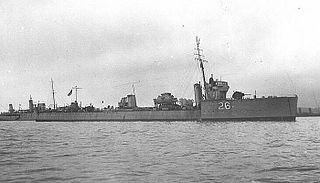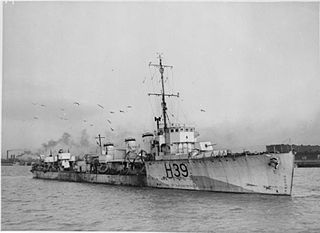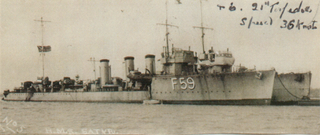Service history
Plumpton was ordered as part of the first group of Racecourse-class minesweepers in September 1915. The ship was constructed by McMillan at their shipyard in Dumbarton, Scotland with the yard number 465 and launched on 20 March 1916. In keeping with the class, the ship was named for the racecourse in Plumpton, East Sussex and construction was completed in June 1916.
Plumpton was attached to the Grand Fleet on completion, being part of the 3rd Minesweeping Flotilla, which was equipped with Racecourse-class ships. [3] The ship was still a member of the 3rd Minesweeping Flotilla in June 1917, [4] but had transferred to the Dover Patrol the next month. [5]
The minesweeper struck a naval mine off the coast of Ostend, Belgium on 19 October 1918. Plumpton was beached on the coast to prevent the ship from sinking. Plumpton was broken up for scrap at the site where she was beached.

HMS Opal was an Admiralty M-class destroyer of the Royal Navy. She served in the First World War following her construction at Sunderland in 1915. Attached to the 12th Destroyer Flotilla based with the Grand Fleet at Scapa Flow, Opal had an eventful short life, which ended in shipwreck after two and a half years of service.

The Racecourse-class minesweepers were 32 ships delivered to the Royal Navy during the First World War. They were built to two related designs as paddlewheel coastal minesweeping sloops under the Emergency War Programme. The vessels were reasonable sea-boats, but lost speed badly in a seaway when the paddle boxes tended to become choked with water. The class is also widely referred to as the Ascot class and Improved Ascot class.

HMS Tipperary, launched on 5 March 1915, was a Royal Navy Faulknor-class destroyer which was sunk in action on 1 June 1916 by the Imperial German Navy at the Battle of Jutland in World War I.
HMS Griffon was a B-class torpedo boat destroyer of the British Royal Navy. She was completed by Laird, Son & Company, Birkenhead, in 1896.

HMS Patrician was a Thornycroft M-class destroyer that served in the British Royal Navy during World War I. The destroyer entered service in 1916 and served with the Grand Fleet. Following the war, the destroyer was deemed surplus and she was transferred to the Royal Canadian Navy in 1920 and served there until 1928. She was sold for scrap in 1929.
HMS E54 was a British E-class submarine built by William Beardmore, Dalmuir. She was laid down on 1 February 1915 and was commissioned in May 1916. She sank the German submarines UC-10 on 21 August 1916 and U-81 on 1 May 1917. E54 was sold for scrap on 14 December 1921.

HMS Active was the name ship of her class of three scout cruisers built for the Royal Navy in the 1910s. Completed in 1911, she was briefly assigned to several different units until the ship became the flotilla leader of the 2nd Destroyer Flotilla (DF) in 1914. When the First World War began in August of that year, the 2nd DF was assigned to the Grand Fleet where their primary task was to protect the fleet from submarines.

HMS Spanker was a Sharpshooter-class torpedo gunboat of the Royal Navy. She was launched in 1889, converted to a minesweeper in 1909 and sold for breaking in 1920.
HMS Starfish was an R-class destroyer which served with the Royal Navy. She was launched on 27 September 1916 and sold to be broken up on 21 April 1928. She was built by Hawthorn Leslie of Hebburn Tyne.
HMS Rother was a Palmer type River-class destroyer ordered by the Royal Navy under the 1902–1903 Naval Estimates. Named after the River Rother, east of Sheffield, South Yorkshire in England, she was the first ship to carry this name in the Royal Navy.
SS Ardena was a minesweeper and escort vessel built as an Azalea-class sloop minesweeper for the British Royal Navy with the name HMS Peony in 1915.

HMS Cockatrice was an Acasta-class destroyer of the British Royal Navy. She was built by Hawthorn Leslie and Company, launching in 1912 and served throughout the First World War. She was sold for scrap in 1921.

HMS Tarpon was a Royal Navy R-class destroyer constructed and operational in the First World War. She is named after the large fish Tarpon; one species of which is native to the Atlantic, and the other to the Indo-Pacific Oceans. Tarpon was built by the shipbuilders John Brown & Company at their Clydebank shipyard and was launched in March 1917 and entered service in April that year.
HMS Lightfoot was a Marksman-class flotilla leader of the British Royal Navy. Construction by J. Samuel White began in June 1914, shortly before the outbreak of the First World War, and the ship was launched and completed in 1915. She survived the war and was sold for scrap in 1921.

HMS Satyr was an R-class destroyer which served with the Royal Navy during the First World War. Launched on 27 December 1916, Satyr joined the Harwich Force under the command of Commander Hubert de Burgh. In 1917, the destroyer formed part of a force protecting the monitors Erebus and Terror in their bombardment of Ostend. As part of this action, Satyr, along with sister ships Taurus, Sharpshooter and Torrent, sank the German destroyer S20. After the war, the ship served with the Torpedo School at the Devonport. In 1923, the Navy decided to retire many of the older destroyers in preparation for the introduction of newer and larger vessels and Satyr was sold to be broken up on 16 December 1926.
HMS Gentian was an Arabis-class sloop that was sent to assist the Baltic States and their fight for independence. While clearing mines on 15 or 16 July 1919, according to different sources, Gentian and the sloop HMS Myrtle both hit mines and sank with the loss of nine sailors.
HMS Myrtle was an Azalea-class sloop that was part of a Royal Navy squadron that was sent to assist the Baltic States and their fight for independence. While clearing naval mines on 16 July 1919 both Myrtle and HMS Gentian hit mines and sank. The two blasts killed nine sailors.
HMS Grasshopper was a Beagle-class destroyer of the British Royal Navy. The Beagles were coal-fuelled ships, designed for a speed of 27 kn, armed with a 4-inch (102 mm gun and two torpedo tubes. Grasshopper was built by Fairfield Shipbuilding & Engineering Company at their Govan yard, between 1909 and 1910, being launched on 23 November 1909 and completing in July 1910.
HMS Cornflower was an Arabis-class sloop of the Royal Navy and from 1933 the Hong Kong Naval Volunteer Force (HKNVR).

HMS Rosemary was an Arabis-class minesweeping sloop of the British Royal Navy. Built by the Teesside shipbuilder Richardson, Duck and Company from 1915–1916, Rosemary carried out minesweeping and anti submarine operations during the First World War. She was used for fishery protection duties during the 1930s, and served through the Second World War, finally being sold for scrap in 1947.










